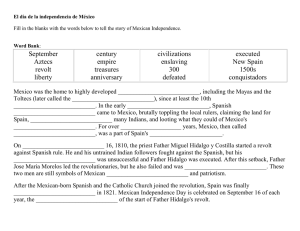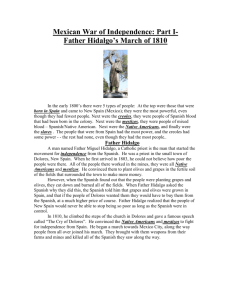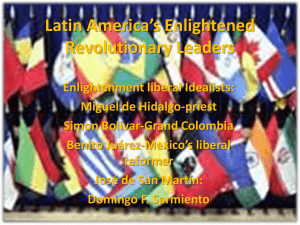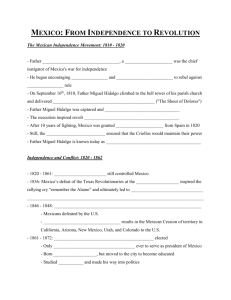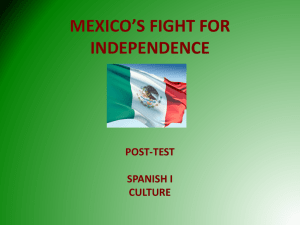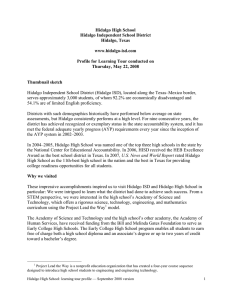Mexico and Central America Independence
advertisement
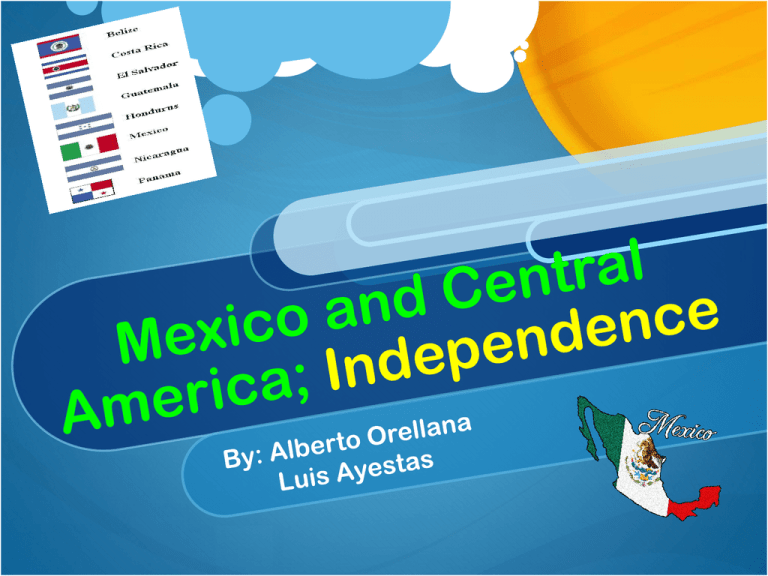
Spanish Arrival In 1502, Christopher Columbus sailed off the coast of Panama. Soon after, Vasco Núñez de Balboa arrived in Panama and then Hernán Cortés arrived in Mexico (later traveling as far South as Honduras). The Spanish arrived and planned to seek wealth and to convert Indians to Christianity. The arrival of the Spanish marks the beginning of what is called the Colonial period. Mexican Independence Mexico's Independence from Spain started in 1810 and ended in 1821. The movement went through several leaders, including Father Miguel Hidalgo and Jose Maria Morelos. Father Miguel Hidalgo kicked off Mexico's struggle for independence from Spain on September 16, 1810 when he issued his famous "Cry of Dolores" in which he exhorted Mexicans to rise up and throw off Spanish tyranny. The conspirators selected early December 1810 as their time to strike. They persuaded many to join their cause. On the morning of the 16th, Hidalgo rang the church bells, summoning the workers from the nearby fields. From the pulpit he announced the revolution: "Know this, my children, that knowing your patriotism, I have put myself at the head of a movement begun some hours ago, to wrest away power from the Europeans and give it to you". Hidalgo would battle royalist forces right to the gates of Mexico City itself, although his “army” was never much more than a poorly-armed and uncontrolled mob more interested in murdering hated Spaniards. The army would fight against General Félix Calleja at the Battle of Calderon Bridge in January of 1811. Hidalgo and Allende were captured and executed. Hidalgo led the independence movement, battling Spanish forces in and around Central Mexico. He was captured and executed in 1811, but others picked up the struggle. Hidalgo is today considered the father of the country. The Cry of Dolores marked the beginning of the long and bloody Mexican War of Independence, which would not conclude until 1821. The combination ineptitude from Spain with longstanding abuses and exploitation of the poor was enough to drive tens of thousands of Indians and peasants to join Hidalgo and his army. After Hidalgo was executed, there were already many in place to pick up his cause, most notably his former student José Maria Morelos. Today, Mexicans celebrate their Independence Day with fireworks, food, flags and decorations. In the public squares of most cities, towns and villages, local politicians reenact the Grito de Dolores, standing in for Hidalgo. In Mexico City, the President traditionally reenacts the Grito before ringing a bell: the bell from the town of Dolores rung by Hidalgo in 1810. Many foreigners mistakenly assume that May fifth, is Mexico’s Independence Day, but that date actually commemorates the 1862 Battle of Puebla. The real day is 16 of September. (September 16, 1810 – September 27, 1821) Central America Independence On September 15th, five Central American nations: Costa Rica, El Salvador, Guatemala, Honduras, and Nicaragua celebrate independence from Spain. Colonial Period The indigenous peoples of Central America did not felt well. In fact, the colonial period was quite disastrous for them. Most of the Indians either died from European diseases, such as smallpox, or were subjugated by the Spaniards to back-breaking labor. In 1811, independence movements broke out in El Salvador and again in 1814 after the restoration of Ferdinand VII. Both revolts were easily suppressed and the political unrest was subsumed into the general political process in the Spanish world that led to the Spanish Constitution of 1812. Between 1810 and 1814, the Captaincy General elected seven representatives to the Cádiz Cortes, in addition to forming a locally-elected Provincial Deputation. In 1821 a congress of Central American Criollos declared their independence from Spain, effective on 15 September of that year. That date is still marked as the independence day by most Central American nations. The Spanish Captain General, Gabino Gaínza, sympathized with the rebels and it was decided that he should stay on as interim leader until a new government could be formed. Independence was short-lived, for the conservative leaders in Guatemala welcomed annexation by the First Mexican Empire of Agustín de Iturbide on 5 January 1822. Central American liberals objected to this, but an army from Mexico under General Vicente Filisola occupied Guatemala City and quelled dissent. When Mexico became a republic the following year, it acknowledged Central America's right to determine its own destiny. On 1 July 1823, the congress of Central America declared absolute independence from Spain, Mexico, and any other foreign nation, including North America and a Republican system of government was established. The Colonial period came to an end in 1821 when Guatemala, El Salvador, Honduras, Nicaragua, and Costa Rica became independent. From 1823-1838, these five countries formed the United Provinces of Central America. Thank You!
